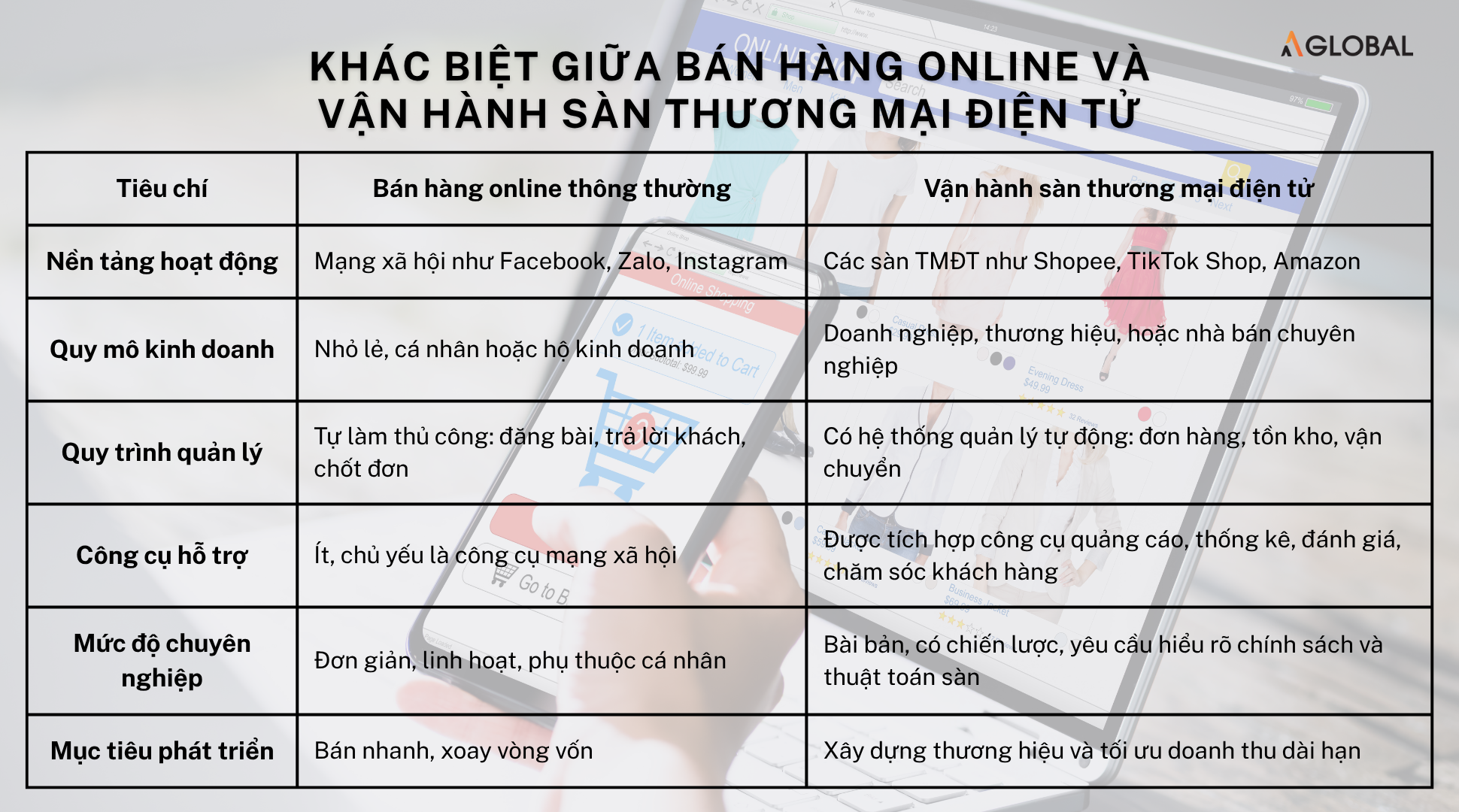
Discover effective e-commerce platform operation solutions
Operating an e-commerce platform plays a vital role in helping businesses maintain business efficiency. However, managing storefronts, processing orders, and optimizing revenue simultaneously is no easy task. The following article will help you understand how e-commerce operations work, the common challenges faced, and effective solutions for sustainable growth in the digital environment.
1. Overview of E-commerce Platform Operations
To effectively operate an e-commerce platform, you must understand its concept and recognize how it differs from traditional online selling models.
1.1. What is E-commerce Platform Operation?
E-commerce platform operation refers to the process of organizing, managing, and optimizing all business activities on online marketplaces such as Amazon, Shopee, and TikTok Shop. These activities include store management, product listings, order processing, customer service, marketing, and business data analysis.
The main goal is to ensure smooth operations, enhance sales efficiency, and deliver the best shopping experience for customers. Today, businesses need to combine technology, structured management systems, and flexible business strategies to maintain their competitive advantage in the fast-changing e-commerce landscape.
1.2. The Difference Between E-commerce Platform Operations and Traditional Online Selling
The distinction lies in scale, management tools, and operational professionalism. While traditional online selling mostly relies on social media and personal management, e-commerce platform operation requires systematic processes supported by automation tools and data-driven management.

The Difference Between E-commerce Platform Operations and Traditional Online Selling
2. Core Activities in E-commerce Platform Operations
To operate effectively, every process must be consistent and backed by a clear strategy. These activities form the foundation for building brand competitiveness and achieving long-term success on e-commerce platforms.
2.1. Building the Customer Journey Map
A customer journey map helps businesses visualize the entire customer experience—from awareness to purchase and repurchase. By understanding customer emotions, needs, and touchpoints, businesses can optimize the shopping experience at every stage.
This insight allows for more effective content creation, promotional planning, and customer care, leading to higher conversion rates and stronger brand loyalty.
Read more: What Is a Customer Journey? How to Create an Effective Customer Journey Map
2.2. Designing an Attractive and Unique Storefront
A professionally designed storefront with high-quality visuals and a clear layout creates a strong first impression. Businesses should invest in authentic product photos, detailed descriptions, and compelling banners with clear messaging. Regular updates also increase credibility and improve product visibility within the platform’s ranking system.
2.3. Implementing Marketing Campaigns
Businesses should combine multiple strategies—paid advertising, promotions, and social media marketing—to drive traffic and boost sales. Leveraging major sale events (such as 9.9, 11.11, or Black Friday) and applying dynamic pricing strategies can help products reach target customers more effectively.
Crucially, performance tracking must be done regularly to adjust costs and strategies for better outcomes.

Read more: Tips for Hunting Amazon Black Friday 2025 Deals Effectively
2.4. Providing Professional Customer Service
Customer service quality directly reflects the credibility of a store. Businesses must ensure prompt responses, timely problem resolution, and attentive support throughout the shopping journey.
Implementing automated messaging systems, professional consultation scripts, and clear after-sales policies enhances customer satisfaction. When customers feel valued, they are more likely to return and recommend the brand to others.
2.5. Monitoring Financial Performance
With tools like Seller Center, businesses can easily monitor revenue reports, profit margins, order statuses, and operational expenses. Regular financial updates help evaluate marketing campaign performance and identify high-profit products.
A transparent financial management system ensures sustainable growth and better resource allocation.
2.6. Managing Orders Effectively
Efficient order management ensures that every step—from order placement to delivery—is smooth and accurate. Businesses should monitor order statuses in real time and address issues such as cancellations, returns, or delays promptly to maintain customer trust.
2.7. Tracking and Evaluating Sales Performance
Regular evaluation is key to improving overall operations. Important metrics include revenue, conversion rate, return rate, customer reviews, and marketing costs.
Periodic data analysis helps identify weaknesses in the process, allowing businesses to refine strategies, improve efficiency, and achieve long-term growth on e-commerce platforms.
3. Common Challenges in E-commerce Operations
Operating on e-commerce platforms involves multiple market and system-related challenges that can directly impact revenue, efficiency, and competitiveness.

4 Challenges in E-commerce Operations
3.1. Fierce Competition
As the e-commerce market expands, thousands of sellers and brands join daily, intensifying competition—especially in popular sectors like fashion, cosmetics, and home goods.
To stand out, businesses must focus on customer experience, brand positioning, and creative marketing strategies to attract and retain customers.
3.2. Complex Order and Data Management
Managing multiple storefronts across different platforms means handling hundreds of orders, inventories, and customer data simultaneously. Without centralized and synchronized systems, errors such as duplicate orders, wrong shipments, or inventory loss may occur.
3.3. Constant Policy Changes
Platforms like Shopee, Lazada, TikTok Shop, and Amazon frequently update their policies on fees, shipping, promotions, and store performance standards.
Failing to adapt in time can lead to reduced visibility, exclusion from promotions, or even account suspension.
3.4. Lack of Experienced Personnel
E-commerce operation requires a team skilled in technology, marketing, logistics, and data analytics—a combination that not all businesses can afford.
Inexperience in store management, ad optimization, or complaint handling often leads to inefficiency.
In such cases, outsourcing to a professional e-commerce agency can ensure smoother operations, cost optimization, and better business results.
4. Hiring an Agency: A Cost-Effective and Strategic Solution
Running an online store in-house requires significant investment in time, manpower, and resources—especially challenging for small and medium-sized enterprises (SMEs).
Hiring an e-commerce operation agency is an effective way to save resources, increase productivity, and ensure stable growth.
4.1. Benefits of Hiring a Professional E-commerce Agency
Partnering with a specialized agency brings numerous advantages:
- Time and cost efficiency: No need to build separate in-house teams for marketing, customer care, or order processing.
- Optimized sales performance: Agencies understand platform algorithms, market trends, and consumer behavior, helping boost visibility, sales, and revenue.
- Clear strategy and measurable results: Agencies provide frequent data analysis and reports, enabling timely decision-making.
- Access to expertise: Experienced specialists help businesses shorten the trial-and-error phase and accelerate growth.
4.2. AGlobal – Comprehensive Solutions for Sustainable E-commerce Growth

AGlobal is a leading Vietnamese company providing full-package e-commerce operation and development solutions.
As an official partner of Amazon and International Growth Agency partner of Google, AGlobal helps Vietnamese businesses expand globally with professionalism and efficiency.
Founded in 2021, AGlobal is headquartered in Hanoi, with branches in Da Nang and Ho Chi Minh City.
With a team of seasoned experts, AGlobal has partnered with 200+ export-oriented businesses across various industries—helping them optimize storefronts, increase sales, and enhance competitiveness.
Beyond operations, AGlobal also offers a comprehensive ecosystem of services, including account management, multi-channel advertising, and e-commerce training.
This enables businesses to accelerate digital transformation, strengthen brand presence, and achieve sustainable international growth.
Read more: AGlobal – The Only Vietnamese Company that is Both an Amazon Global Selling Account Management and Advertising Partner
5. Conclusion
For smooth and effective e-commerce operations, businesses must establish clear processes, embrace technology, and continuously optimize their activities.
With the insights and best practices shared in this article, businesses can gain a clearer understanding of platform operations, identify challenges, and choose the most suitable solutions for their goals.
AGlobal – The leading cross-border e-commerce solution for Vietnamese businesses.
Register for a free 1-on-1 consultation tailored to your industry Here!
